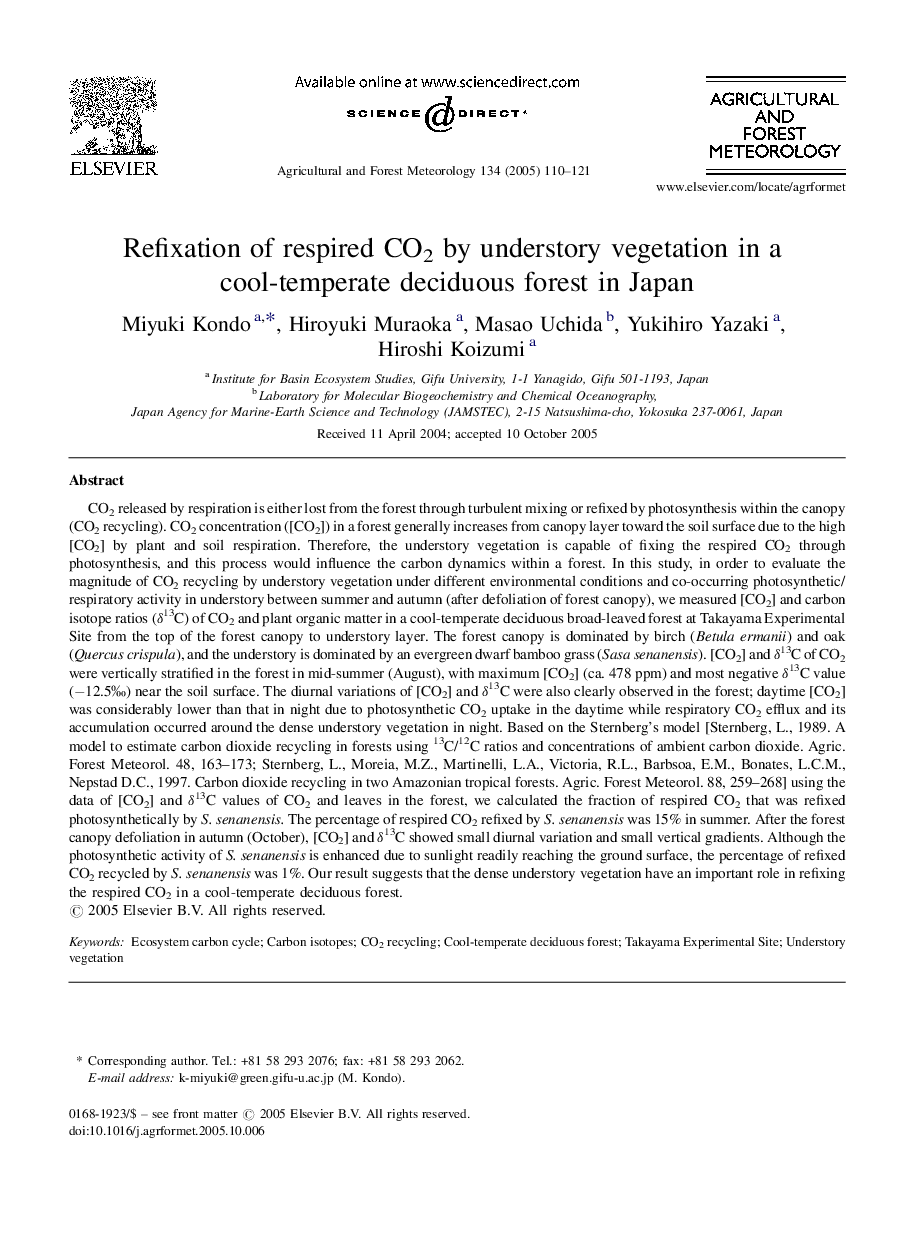| کد مقاله | کد نشریه | سال انتشار | مقاله انگلیسی | نسخه تمام متن |
|---|---|---|---|---|
| 9619414 | 158429 | 2005 | 12 صفحه PDF | دانلود رایگان |
عنوان انگلیسی مقاله ISI
Refixation of respired CO2 by understory vegetation in a cool-temperate deciduous forest in Japan
دانلود مقاله + سفارش ترجمه
دانلود مقاله ISI انگلیسی
رایگان برای ایرانیان
کلمات کلیدی
موضوعات مرتبط
مهندسی و علوم پایه
علوم زمین و سیارات
علم هواشناسی
پیش نمایش صفحه اول مقاله

چکیده انگلیسی
CO2 released by respiration is either lost from the forest through turbulent mixing or refixed by photosynthesis within the canopy (CO2 recycling). CO2 concentration ([CO2]) in a forest generally increases from canopy layer toward the soil surface due to the high [CO2] by plant and soil respiration. Therefore, the understory vegetation is capable of fixing the respired CO2 through photosynthesis, and this process would influence the carbon dynamics within a forest. In this study, in order to evaluate the magnitude of CO2 recycling by understory vegetation under different environmental conditions and co-occurring photosynthetic/respiratory activity in understory between summer and autumn (after defoliation of forest canopy), we measured [CO2] and carbon isotope ratios (δ13C) of CO2 and plant organic matter in a cool-temperate deciduous broad-leaved forest at Takayama Experimental Site from the top of the forest canopy to understory layer. The forest canopy is dominated by birch (Betula ermanii) and oak (Quercus crispula), and the understory is dominated by an evergreen dwarf bamboo grass (Sasa senanensis). [CO2] and δ13C of CO2 were vertically stratified in the forest in mid-summer (August), with maximum [CO2] (ca. 478 ppm) and most negative δ13C value (â12.5â°) near the soil surface. The diurnal variations of [CO2] and δ13C were also clearly observed in the forest; daytime [CO2] was considerably lower than that in night due to photosynthetic CO2 uptake in the daytime while respiratory CO2 efflux and its accumulation occurred around the dense understory vegetation in night. Based on the Sternberg's model [Sternberg, L., 1989. A model to estimate carbon dioxide recycling in forests using 13C/12C ratios and concentrations of ambient carbon dioxide. Agric. Forest Meteorol. 48, 163-173; Sternberg, L., Moreia, M.Z., Martinelli, L.A., Victoria, R.L., Barbsoa, E.M., Bonates, L.C.M., Nepstad D.C., 1997. Carbon dioxide recycling in two Amazonian tropical forests. Agric. Forest Meteorol. 88, 259-268] using the data of [CO2] and δ13C values of CO2 and leaves in the forest, we calculated the fraction of respired CO2 that was refixed photosynthetically by S. senanensis. The percentage of respired CO2 refixed by S. senanensis was 15% in summer. After the forest canopy defoliation in autumn (October), [CO2] and δ13C showed small diurnal variation and small vertical gradients. Although the photosynthetic activity of S. senanensis is enhanced due to sunlight readily reaching the ground surface, the percentage of refixed CO2 recycled by S. senanensis was 1%. Our result suggests that the dense understory vegetation have an important role in refixing the respired CO2 in a cool-temperate deciduous forest.
ناشر
Database: Elsevier - ScienceDirect (ساینس دایرکت)
Journal: Agricultural and Forest Meteorology - Volume 134, Issues 1â4, 30 November 2005, Pages 110-121
Journal: Agricultural and Forest Meteorology - Volume 134, Issues 1â4, 30 November 2005, Pages 110-121
نویسندگان
Miyuki Kondo, Hiroyuki Muraoka, Masao Uchida, Yukihiro Yazaki, Hiroshi Koizumi,